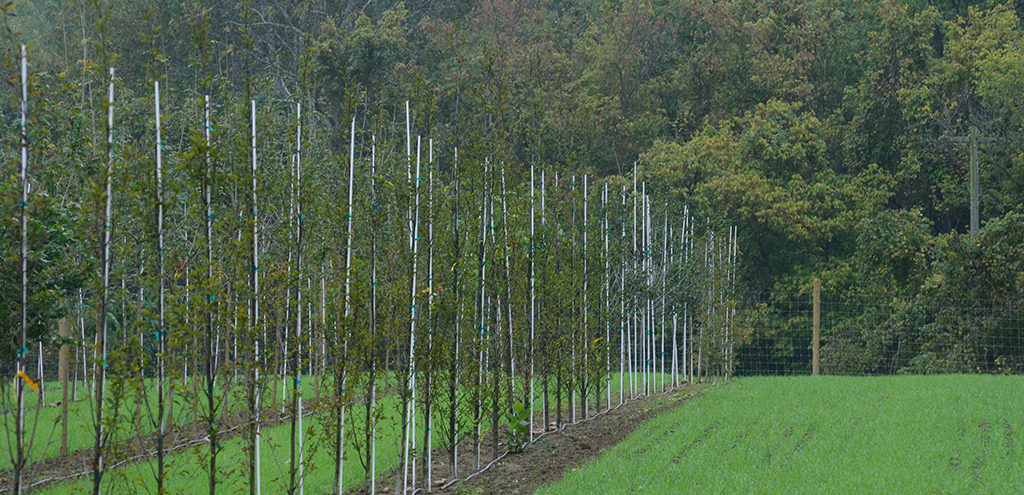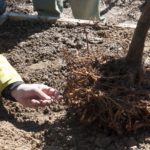THE LEAFLET

#ICYMI: The Washington Post Featured the Casey Tree Farm
Ever wanted to know where we get most of our trees or what exact we do out at our farm in Berryville, VA? Look no further! The Washington Post recently visited us and wrote an article all about our planting techniques and challenges, and more about our trees’ journey to their home in the District. Therefore, we couldn’t help but share it with our people!
Want to be a part of setting trees up for success in the concrete jungle? Sign up to learn more about urban forestry, become a tree advocate to speak up for trees, or contribute to the canopy. Any bit helps us reach our canopy goal!
Sourced from Preparing trees to go from green pastures to the concrete jungle, Adrian Higgins, Washington Post
The rolling hills of the Casey Tree Farm in Clarke County, Va., seem a million miles and a distant age from the real estate bustle of the District of Columbia and its constant reinvention, but these pastures offer the city future relief in a climate-changing century.
 Here, Todd Woodfield and his crew are running a tree factory, raising some 12,000 trees from sapling to sturdy transplant. More than 3,000 are ready for planting each year, when they make the 65-mile journey east for a new life in city parks, schools, neighborhoods and other places where Casey Trees is trying to maintain and increase the urban forest.
Here, Todd Woodfield and his crew are running a tree factory, raising some 12,000 trees from sapling to sturdy transplant. More than 3,000 are ready for planting each year, when they make the 65-mile journey east for a new life in city parks, schools, neighborhoods and other places where Casey Trees is trying to maintain and increase the urban forest.
The nonprofit organization was established by philanthropist Betty Brown Casey in 2002, following reports of a precipitous decline in the city’s tree canopy.
Since then, issues of greenhouse gases, global warming and flooding have made the quest for a leafy city all the more pressing.
The city has its own vigorous tree-planting program and will install almost 9,000 trees between October and April, most of them street trees, said Earl Eutsler, associate director of the Urban Forestry Division.
Both the city and Casey Trees have set a goal of a tree canopy covering 40 percent of the District by 2032. It’s now about 38 percent and at one time in living memory was 50 percent.
The urban tree faces unique perils: constricted roots, poor soil, drought, flood and the effects of construction. It is this future that gives the tree farm an added piquancy.
The pastures are marked by rows of white glass fiber rods, each about eight feet high, perfectly vertical and spaced six feet apart. Each row is 10 feet from the next. The rods mark the contours of the hills, but also the placement of hundreds, thousands, of young trees. They are strangely hard to see from afar in the dim December light, now that the leaves have dropped. Nearby, the Shenandoah River meanders on its northward journey to Harpers Ferry, W.Va.
Woodfield, the general manager, brings decades of experience in the nursery business but also an aversion to traditional tree farm practices of feasting plants on a main course of synthetic fertilizers and a dessert of pesticides. He occasionally sprays the herbicide glyphosate to check weed competition, but the care and feeding of the tree comes down to adjusting the pH of the well-fed irrigation system (the water’s too alkaline) and maintaining the right balance of micronutrients such as calcium and manganese.
As we spent a chilly couple of hours in the fields, he kept returning to the need to maintain proper levels of cation exchange capacity. This is a measure of the soil’s ability to store nutrients until roots need them.
He can also pick and juice green leaves to test whether the tree is making enough chlorophyll to feed itself, and adjust organic nutrient levels accordingly. His goal is to get the plants from a whip to a 10- to 12-footer with a two-inch trunk caliper in two growing seasons.
 Each tree is pruned at least once a year, with the aim of getting a balance of thickness to height and a strong central leader. The stakes flex in the wind, and this movement encourages a stouter trunk.
Each tree is pruned at least once a year, with the aim of getting a balance of thickness to height and a strong central leader. The stakes flex in the wind, and this movement encourages a stouter trunk.
But it is the way these trees are grown that is just as interesting to a gardener and tree-hugger like me.
Years ago, saplings used to be cleaned of all soil after digging and were shipped bare-root. This is a risky way to move plants, and most plants that reach consumers today have roots wrapped in sacking — “ball and burlap” — or grown in large plastic containers.
But both techniques have their drawbacks. A root ball wrapped in burlap is from a field-grown tree that has been dug with a mechanical tree spade. This can remove as much as 95 percent of the young tree’s root mass. Container-grown plants can have the opposite problem, of too many roots. If left too long, the roots simply encircle the interior of the pot and are reluctant to get off their merry-go-round once planted in the ground, to the plant’s long-term detriment.
The tree farm uses another technology. The saplings arrive from growers in containers. Woodfield and his colleagues go to the bother of replanting them in fibrous pouches known as Root Control Bags. These are buried in the rows. Once the tree roots reach the edge, the leading root hairs grow through but then are pinched by the fabric. This causes the roots to develop a thick, branched mass and allows the trees to be planted without the trauma of the other systems.
“I can harvest this when it’s 100 degrees, ship it to your place, cut the bag off and it’ll never know it left the nursery,” Woodfield said, standing by a row of American beeches. Another benefit: The trees are lighter and more maneuverable than ball and burlap or containerized versions, easier to haul through a rowhouse to the back yard, or for volunteers to plant. “We are very keen to incorporate these trees into our planting program,” said Eutsler, who has used them at D.C. Housing Authority properties.
The tree farm property, which includes a large historic house and other homes, used to be Casey’s personal summer retreat. She transferred its 700 acres to the foundation in 2008. Casey Trees spent a couple of years fixing up buildings before establishing the tree nursery. A total of 40 acres is wrapped in an extensive eight-foot deer fence.
The farm has allowed Casey Trees to plant more trees than in the past, when plants were simply bought from other tree farms, but more than that it gives the organization increased flexibility in choosing the type, quantity, quality and timing of trees for its needs, said Mark Buscaino, executive director. In the parlance of mega-retailing, “it gives us pipeline control,” he said.
Since the farm opened, he has reduced the range of species from about 100 to 40, to focus on the types they need most, and increased quantities.
I asked Woodfield to name some of the more popular trees for use in an urban setting, and he listed red maple, swamp white oak, black gum, sweetbay magnolia and American beech. The inventory also includes such underused but lovely native trees as the scarlet and overcup oaks, the Kentucky coffee tree and the American hornbeam and hophornbeam.
Beyond its utilitarian value, the farm offers a pleasant rural counterpoint to the city and is used for events for donors and volunteers.
“It’s a beautiful place, so it’s a way for us to really create connections and get folks to understand what it takes to produce trees. It gets people jazzed up,” Buscaino said.
I told him I felt sorry for the trees in a way, that they were enjoying these pastures before the hardships of the concrete jungle.
Buscaino shares no such pang. “They’re really needed back in the city,” he said, laughing, “where they’ll be doing their civic duty.”